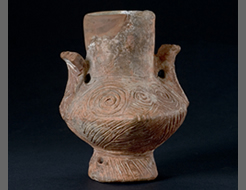|
||||||||||||||||||||||||||||||||
|
|
Museum of: Athens | |||||||||||||||||||||||||||||||
| Name of the artefact: Clay anthropomorphic vase | ||||||||||||||||||||||||||||||||
|
Clay hand-made vase decorated with incised spiral and
zig-zag motives. The tripartite structure (neck-belly-base) and the horned
handles recall a human figure. |
||||||||||||||||||||||||||||||||
|
WHERE IS IT AND MAIN
CHARACTERISTICS |
STATE |
|||||||||||||||||||||||||||||||
|
Department: |
Prehistoric |
Preservation: |
Good | |||||||||||||||||||||||||||||
|
Inventory number: |
5927 |
Restauration: |
Restored | |||||||||||||||||||||||||||||
|
Name of the artefact: |
Clay anthropomorphic vase |
Completeness: |
Almost Complete | |||||||||||||||||||||||||||||
|
Object type: |
Vessel/Anphora |
|||||||||||||||||||||||||||||||
|
Material: |
Clay |
|||||||||||||||||||||||||||||||
|
Methof of manufacture: |
Hand made |
|||||||||||||||||||||||||||||||
|
Decoration
type: |
Incision |
|||||||||||||||||||||||||||||||
|
Distinctive mark: |
Abstract anthropomorphic
structure |
|||||||||||||||||||||||||||||||
|
DIMENSIONS |
PERIOD OF USE |
|||||||||||||||||||||||||||||||
|
Length (mm): |
- |
Epoque: |
Neolithic |
|||||||||||||||||||||||||||||
|
Heigth
(mm): |
107 |
Culture: |
Classical Dimini |
|||||||||||||||||||||||||||||
|
Diameter
(mm): |
- |
Period: |
Late Neolithic II |
|||||||||||||||||||||||||||||
|
Width (mm): |
- |
Face: |
- |
|||||||||||||||||||||||||||||
|
Thickness (mm): |
- |
Absolute chronology: |
4800-4500 BC |
|||||||||||||||||||||||||||||
|
Weight
(g): |
- |
|||||||||||||||||||||||||||||||
DISCOVERY |
||||||||||||||||||||||||||||||||
|
Date: |
1902 |
Country: |
Greece |
|||||||||||||||||||||||||||||
|
District: |
Thessaly |
Town hall affiliation: |
Volos |
|||||||||||||||||||||||||||||
|
Village: |
Dimini |
Discovery findspot: |
Neolithic settlement of
Dimini |
|||||||||||||||||||||||||||||
|
Condition of discovery: |
Archaeological excavation |
Discovery type: |
Deposit |
|||||||||||||||||||||||||||||
|
ANALYSES – DETERMINATIONS |
FILLED IN BY |
|||||||||||||||||||||||||||||||
|
Type: |
- |
Name: |
Alexandra Christopoulou |
|||||||||||||||||||||||||||||
|
Laboratory: |
- |
Institution: |
National Archaeological Museum -
Greece |
|||||||||||||||||||||||||||||
|
No./Code: |
- |
Date: |
21/11/2005 |
|||||||||||||||||||||||||||||
|
DEEPENINGS |
||||||||||||||||||||||||||||||||
|
Morphology of the object: |
||||||||||||||||||||||||||||||||
|
Small elegant incised vase of reddish clay with high
cylindrical neck and small conical base/foot. Two peculiar solid curved
handles are attached symmetrically to the shoulders. They begin at the
middle of the belly and open upwards, like wings as high as the middle of
the neck. At the base of the neck these handles are pierced horizontally.
The belly is spherical, a bit compressed, and its peculiarity lies in the
two pointed protrutions, each formed symmetrically between the handles.
The small base, hollowed underneeth, has been attached separately and
looks rather unstable to support the vase. It has also been pierced with a
pair of holes which correspond with those of the handles. |
||||||||||||||||||||||||||||||||
|
Decoration: |
||||||||||||||||||||||||||||||||
|
The vase has been decorated with incision. Apart from
the smooth undecorated neck, the body, the handles and the base are
covered with a system of deep incisions or grooves: the zig-zag pattern
has been formed on the lower body and the handles; the uper part on both
faces between the handles has been embellished with three spirals, the
middle one being smaller than the others. The base is decorated with dense
parallel oblique lines. Traces of white pigment in some lines proove that
there was an infill of white pigment inside all the incisions. The result
must had been exquisite, with the warm red surfase looking as embroidered
with these white symmetrical and neat patterns. The lack of decoration on
the neck could be an indication – though without parallels - that there
existed a lid which covered it up to the handles. |
||||||||||||||||||||||||||||||||
|
Inscription: |
||||||||||||||||||||||||||||||||
|
- |
||||||||||||||||||||||||||||||||
|
Analogies: |
||||||||||||||||||||||||||||||||
|
The Late Neolithic phase II at Thessaly (4800-4500 BC)
has been also called ‘the Dimimi Culture’, from the neolithic settement of
Dimini. This site was excavated at the beginning of the 20th century and
for the next 50 years became the most important reference site to the
study of the Late Neolithic period in prehistoric archaeology in Greece
and the Balkans. Οne of the most characteristic elements found in the
layers, was the two pottery types, the two ways of decoration of the
vases. The one is the Painted and the other is the Incised Pottery. The
decorative motives in both were elegant geometric designs, the meander,
the checkered, densed parallel / succesive lines and the stepped motif. In
addition to the above, during this period the prevailing new motif was the
spiral, which, in some cases, presence is irrelevant and intusive to the
basic decoration, as in the pinted phiale (photo) no. 5920 from Dimini.
|
||||||||||||||||||||||||||||||||
|
Interpretation: |
||||||||||||||||||||||||||||||||
|
This small vase can not be considered as a common
utensil. Actually, it must have been special even during its time. Its
tripartite structure recalls human body in abstraction, as it has been
described above. One could go further and suggest that this
anthropomorphic vase renders a female figure, based on two factors: the
pointed protrusion at the middle of the body / belly of the vase, and the
three incised spirals on this protruded surface. The spiral motif, when
found on figurines is placed usually on the belly or on the brests ( photo
no M 2749,Volos Museum). Thus, this small vase must represent a female
figure and such rendering is in accordance with the fashion practised
during the Late and Final Neolithic periods, in which a lot of
anthropomorphic vases were created (photos 5933 Dimini, and Diros D.640),
most probably for ritual ceremonies. |
||||||||||||||||||||||||||||||||
|
Bibliography: |
||||||||||||||||||||||||||||||||
|
- |
||||||||||||||||||||||||||||||||

